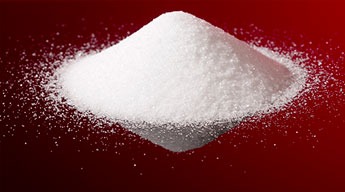IUPAC Name
2,3-Dihydroxybutanedioic Acid
Cas Number
87-69-4
HS Code
2918.12.00
Formula
HOOC(CHOH)2COOH
Industry
Food Ingredients
Appearance
White Crystalline Powder
Common Names
Tartaric Acid
Packaging
25 kg HDPE bag, 25 kg paper bag
Tartaric acid is a white crystalline diprotic aldaric acid. It is predominantly found naturally in several plants, particularly bananas, grapes, and tamarinds. It is a useful raw material in organic chemistry for synthesizing other chiral molecules.
Tartaric acid is obtained from a naturally-occurring component of lees, a solid by-product of fermentation. The former by-products mostly consist of potassium bitartrate (KHC4H4O6). This potassium salt is converted to calcium tartrate (CaC4H4O6) upon treatment with milk of lime (Ca(OH)2):
KO2CCH(OH)CH(OH)CO2H + Ca(OH)2 → Ca(O2CCH(OH)CH(OH)CO2) + KOH + H2O
Higher yields of calcium tartrate are obtained with the addition of calcium chloride. Calcium tartrate is then converted to tartaric acid by treating the salt with aqueous sulfuric acid.
This process yields tartaric acid:
Ca(O2CCH(OH)CH(OH)CO2) + H2SO4 → HO2CCH(OH)CH(OH)CO2H + CaSO4
Tartaric acid is a white crystalline diprotic aldaric acid. It is predominantly found naturally in several plants, particularly bananas, grapes, and tamarinds. It is a useful raw material in organic chemistry for synthesizing other chiral molecules.
Tartaric acid is obtained from a naturally-occurring component of lees, a solid by-product of fermentation. The former by-products mostly consist of potassium bitartrate (KHC4H4O6). This potassium salt is converted to calcium tartrate (CaC4H4O6) upon treatment with milk of lime (Ca(OH)2):
KO2CCH(OH)CH(OH)CO2H + Ca(OH)2 → Ca(O2CCH(OH)CH(OH)CO2) + KOH + H2O
Higher yields of calcium tartrate are obtained with the addition of calcium chloride. Calcium tartrate is then converted to tartaric acid by treating the salt with aqueous sulfuric acid.
This process yields tartaric acid:
Ca(O2CCH(OH)CH(OH)CO2) + H2SO4 → HO2CCH(OH)CH(OH)CO2H + CaSO4
